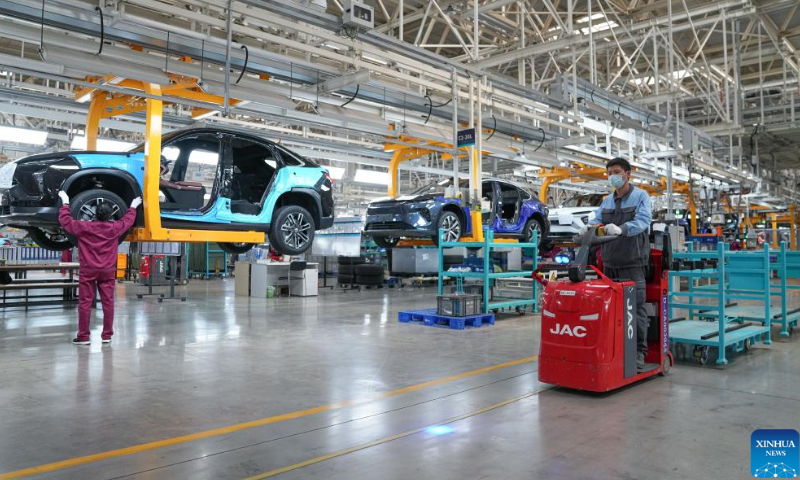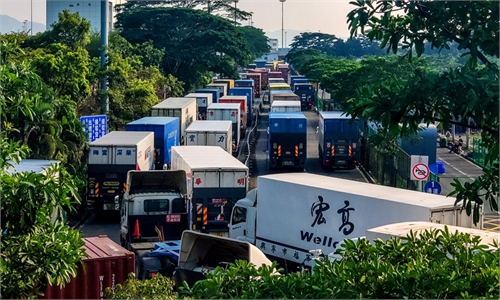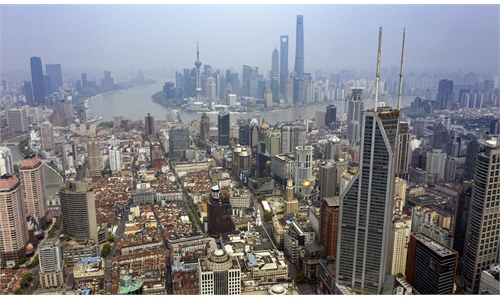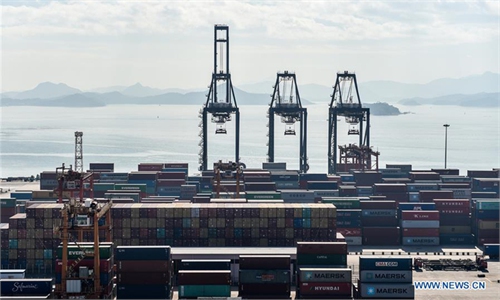
Technicians work on a vehicle production line at the NIO manufacturing base in Hefei, east China's Anhui Province, April 21, 2022. (Xinhua/Du Yu)
While Shanghai and neighboring cities are fighting the worst COVID-19 flare-ups in 2022, the country's most vibrant manufacturing base - the Yangtze River Delta region - still reported better-than-expected GDP results in the first quarter of the year, propped up by the fast growth in advanced manufacturing.
East China's Anhui Province's GDP reached 1.03 trillion yuan ($157.86 billion), up 5.2 percent year-on-year. Zhejiang Province reported a GDP growth rate of 5.1 percent, while Jiangsu Province saw its economy grow 4.6 percent year-on-year. The Yangtze River Delta region drives nearly one-quarter of China's GDP growth.
Shanghai, the epicenter of China's latest wave of COVID-19 outbreaks, reported a slower GDP growth rate of 3.1 percent in the first quarter.
Although the epidemic resurgence has dampened consumption and disrupted supply chains, the region as a whole posted fast growth in advanced manufacturing and the digital economy, playing a vital role in stabilizing the Yangtze River Delta's economy.
For example, Zhejiang's industrial added-value increased by 9.9 percent in the first quarter. The industrial output of the core industry of the digital economy, high-tech and strategic emerging sectors surged by 17.8 percent, 22.7 percent and 16.3 percent year-on-year, respectively.
Jiangsu Province's digital economy posted robust growth momentum, with enterprises' internet and related services reporting a 34.9 percent year-on-year jump in revenue.
One major factor for the Yangtze River Delta region to resist the impact of the epidemic is industrial transformation and upgrading, with a focus on the high-quality development of high-tech and emerging industries, Zhou Dewen, deputy director of the China Association of Small and Medium Enterprises, told the Global Times on Monday.
"The high-tech industry has become a crucial engine for the region to stabilize growth, adjust its economic structure and promote transformation," he said.
Boasting a talent hub, a complete industrial chain and a high level of technology development, the region is summoning its forces and giving full play to its advantage of a mature industrial chain and supply chain, Zhou said.
For example, to support the smooth production of key enterprises in Shanghai, the other three provinces have set up a special work group to coordinate the production and supply of upstream and downstream enterprises to ensure smooth intra-provincial transport of core component and raw materials.
To stimulate the private economic hub after effectively putting the latest outbreak under control, more positive fiscal policies are needed, Xi Junyang, a professor at the Shanghai University of Finance and Economics, told the Global Times on Monday.
Xi said that the budget deficit ratio could be raised to 3-3.5 percent of GDP for the full year.
As small and micro-sized businesses, which create about 80 percent of China's jobs, are particularly sensitive to shocks brought about by COVID-19, major cities in the region have rolled out measures to alleviate cash crunch.
Favorable policies such as tax and fee reductions as well as rent concessions have been introduced for tens of thousands of private enterprises and individual entrepreneurs in the region. It's estimated that tax-related measures taken by Shanghai would reduce the enterprises' burden by 140 billion yuan this year.
"With help from the government, businesses themselves should actively strive for 'change' so as to find new competitive advantages and contribute to the country's economic recovery," Zhou said.



